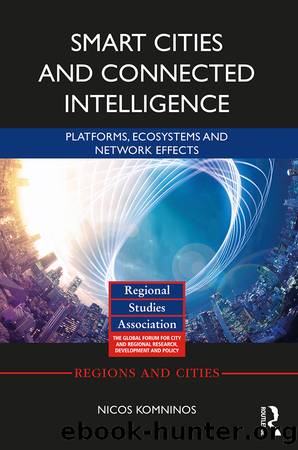Smart Cities and Connected Intelligence by Nicos Komninos;

Author:Nicos Komninos; [Неизв.]
Language: eng
Format: epub
Publisher: Taylor & Francis (CAM)
Published: 2019-11-27T20:00:00+00:00
6.1 Smart growth strategies and platforms
Smart growth strategies share some fundamental properties. They are characterised by a series of innovations and disruptions introduced by combined Internet, World Wide Web, and data processing technologies. Connectivity, data and software applications enable global information flows across continents and time zones; large-scale user engagement in various domains over crowdsourcing platforms; insights for innovation from data, big datasets and analytics; simulation environments for new product development and innovation; the rise of the sharing economy; new forms of production, such as demand-driven production, distributed collaborative production, customer co-production, and various other forms of network-based production and exchange.
The drivers of smart growth are not restricted to digital technologies, but also comprise human capabilities and cognition, intense communication and collaboration. Antonelli and Cappiello (2016, p. 32) argue that in smart development the concept of âsmartnessâ can be applied to both the demand and the supply sides of markets, to static and dynamic features of growth, and refer to three elements of smart growth, the central role of the Internet and World Wide Web, digital infrastructure that connects with human capital and skills, and user participation, co-design and collaboration.
Another key feature of smart growth strategies is related to cognition and productive differentiation. Smart growth can be considered as a stage of âcognitive-cultural capitalismâ (Scott, 2017), a term that refers explicitly to the fundamental role of cognition in development and the dominance of knowledge-intensive sectors, high-tech devices, software, financial and business services, and the wider media industry. There is evidence that industrial branching and knowledge spillovers towards these knowledge-intensive industries do not originate from spatial proximity and agglomeration only, but from technological and cognitive proximities as well (Boschma, 2005; Antonelli and Leoncini, 2016). A direct implication of the role of related variety is the focus on external environments that offer information interconnection and cognitive proximity. While spatial proximity takes place in agglomerations and clusters, digital proximity is achieved in digital and cyber-physical systems, smart and intelligent cities. We may observe here seeds of ideas about platforms and smart ecosystems for urban and regional development.
Smart growth strategies start from a market failure condition. In smart growth, the idea of market efficiency â that growth needs just to let the markets work and not interfere with their operations â is not defensible (Niosi, 2010). On the contrary market failure is rather the rule. It is caused by specificities of knowledge valorisation, uncontrolled spillovers, non-defendable intellectual property, and various barriers in capturing value from knowledge and intangible assets within digital environments. All these barriers point out the need of positive externalities and policy-based guidance for growth.
We should add here the platform logic as a fundamental feature of smart growth strategies. Digital assets, such as commons, smart environments and datasets, create platforms that offer advantages and externalities. The platform logic is gaining prominence in economic renewal as it enables the utilisation of collective intelligence that springs from the diversity of citizens and other stakeholders involved in innovation processes (Anttiroiko, 2016; Carayannis and Rakhmatullin, 2014; Cooke and De Propris, 2011; Panori et al.
Download
This site does not store any files on its server. We only index and link to content provided by other sites. Please contact the content providers to delete copyright contents if any and email us, we'll remove relevant links or contents immediately.
Storytelling for dummies by Andrea Fontana(1469)
Effortless by Greg McKeown(1391)
The Practice by Seth Godin(1370)
Mastering Blockchain by Lorne Lantz(1366)
Blockchain Quick Reference by Paul Valencourt & Samanyu Chopra & Brenn Hill(1120)
Mastering Blockchain by Lorne Lantz & Daniel Cawrey(890)
How to Lead by David M. Rubenstein(789)
The wind in the willows by Kenneth Grahame(773)
The Ape in the Corner Office by Richard Conniff(762)
Handbook of Big Data Analytics by Unknown(690)
Social Media Engagement For Dummies by Aliza Sherman(685)
FunRetrospectives: activities and ideas for making agile retrospectives more engaging by Paulo Caroli & Tainã Caetano Coimbra(668)
Getting Started with Data: The first book you should read to successfully get along with data. by Menegatti Gabriel & Team Simbiose Ventures(668)
Taking Care of Yourself (HBR Working Parents Series) by Harvard Business Review(668)
Business Storytelling For Dummies by Unknown(647)
Evernote for Self Publishing: How to Write Your Book in Evernote from Start to Finish by Jose John(639)
Help! My Facebook Ads Suck-- by M. D. Cooper & Jill Cooper(633)
A Leader Listens by Ajay Banga(612)
Genius by Choice: Your unconventional A–Z handbook to enhance your learning process by Remondino Giulia S(612)
